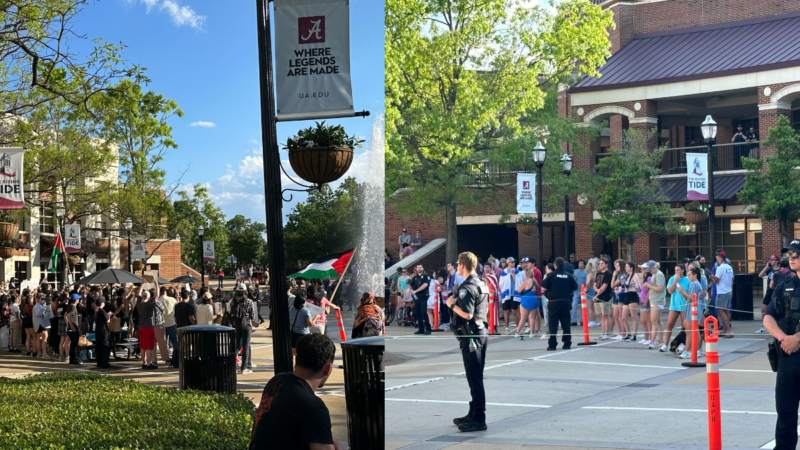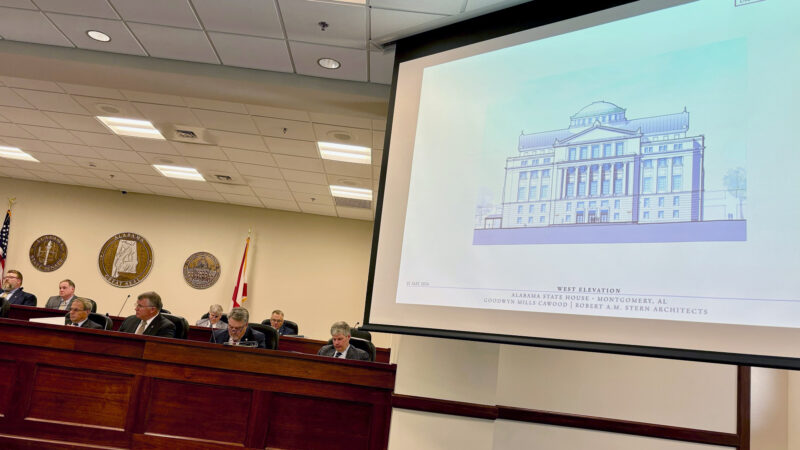Asian Soybean Rust
It’s a sunny but cold Mid November Saturday in Dothan. The cold is what’s
killing a big bed of kudzu between cotton fields and the passing cars on
highway 431. But not all the plants are dead, and some of those are
host to a devastating little devil-the Asian Soybean rust spore. The spore sucks
the life out of kudzu, which wouldn’t bother many horticulturalists… but
the spore also has a taste for another legume – Soy beans. Infected plants can’ t mature-meaning, smaller harvests and smaller revenues for farmers. And it’s
difficult to contain the fungi because it moves with the wind.
The spore originates in Asia and took the scenic route over to the states,
stopping off in Africa and South America. Before the diseased arrived, climatologists believed it would take the perfect storm to scoop up the spores in
Brazil and carry them over the ocean before dumping them along the Gulf Coast.
That perfect storm came in the form of Hurricane Ivan, which dumped millions upon millions of rust spores in the southeast. Shortly after the storm, scientists detected spores in Louisiana. Soon after, they found them in Georgia, Alabama, Florida, and within a year the range of the spores stretched from Texas to North Carolina.
“It’s certainly important to know the where the spores are and how widespread the disease is.
That’s Dr. Robert Wisner, an economist and grain-marketing specialist at
Iowa State University. Wisner sits on the Iowa Soybean Rust Task Force, which is
charged with protecting that state’s $2 billion soy crop. So far rust spores haven’t made their way up to the Midwest. But Wisner says eventually they will, and farmers in Iowa need to know what’s going on in Alabama and the rest of the southeast.
“That gives us some clues as to the likely hood of those spores blowing in to Iowa.
Currently, farmers fight the disease with expensive fungicides that have to
be applied at a specific time to be effective. If a farmer is late to spot the rust, and has to spray the crops twice, that could eliminate any profit the soybeans would have been brought in. So while climatologists watch the wind patterns, plant pathologists like Auburn University’s Ed Sikora are watching the ground. Sikora is a leading figure in the fight against spores. He’s also set the record for the most spore discoveries in a single day.
“My competitive juices were running because Georgia was getting ahead of us. So over about a 24-hour period, I traveled up the eastern edge of Alabama going county to county and looking at kudzu patches and soybean fields and I managed to find rust in ten counties along that edge.
The Alabama-Georgia Border is ground zero for the rust spores, and there’s
lots of friendly competition between scientists from the two states. University of Georgia researchers say they were in awe of Sikora’s mad dash to track the spore. But the Georgia researchers are also gaining attention for their work in the fields.
“I think the only thing more boring than rating plots is you watching me rate plots.”
He may think it’s boring, but Dr. Bob Kemeriat’s work could save farmers billions of dollars. On a windy weekday afternoon, Kemeriat is in Attapulgus, Georgia, looking over soy leaves. He’s interested in how quickly the plants succumb to the
fungi.
“You can see it starts in the lower canopy; a few leaves are
dropping, as you move up to towards the top of the plant it’s not there.
Kemerait is searching for the spores-which look like little balls of rust
you’d find on an old washing machine or tin can.
“Unless you knew what you were looking for, you’d never see it. Especially if you were scouting a field driving by in your pick-up truck, it’d be tough.
Kemeriat is joined in the field by Dr. Leila Skonyers. They’re searching with hopes of finding what they call the Holy Grail of soy – a rust proof plant.
“So far we haven’t been able to find that Holy Grail plant. Most
Legumes we come across have some sort of susceptibility to rust. But if we do
find it will be of great help to the grower.
But for now, the biggest help to farmers isn’t scientists with a friendly
AL-GA rivalry. It’s mother nature. Growers are hoping it gets cold enough in
places like Dothan, to kill the kudzu, and the soybean rust spore.
Gambling bill in doubt with three days left in the legislative session
Alabama lawmakers are coming down to the finish line for this year’s legislative session. Many bills await passage, but perhaps the biggest one up in the air is a lottery and gambling bill.
Pro-Palestinian demonstration draws counter-protest at University of Alabama
Students gathered demanding the school call for a permanent and immediate ceasefire and to push the school to sever ties with defense contractor Lockheed Martin.
A new Statehouse and related projects will cost about $400 million
The Alabama Legislative Council, a 20-member panel comprised of legislative leaders and their appointees, approved the construction of the new Statehouse last year. The panel was given an update on the project on Wednesday.
New pilot program will offer housing, resources to people leaving prison
The Birmingham Reentry Alliance will provide wrap around services to dozens of men and women adjusting to life after prison.
Alabama committee advances ban on LGBTQ+ pride flags in classrooms
The Senate Education Policy Committee voted 5-2 for the House-passed bill, putting the proposal in line for a possible final passage in the last four days of the legislative session.
A New Orleans garden paid hundreds of dollars in fees for a sewer that doesn’t exist
Galvez Garden owner Lissie Stewart has been fighting the New Orleans Sewerage and Water Board over inaccurate billing for years.







